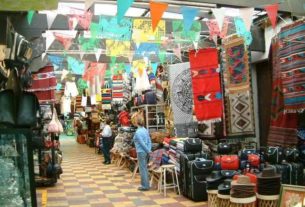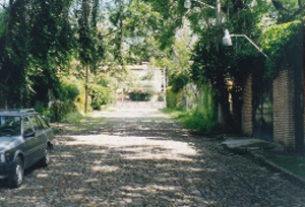In March 2023 the city of Guadalajara dedicated a new monument to world-renowned engineer-architect Luis Barragán. The monument, El Palomar, was originally designed by Barragán in the 1970s but did not come to fruition until many years after his death.

Barragán’s career has been extensively documented. However, the emphasis has usually been on his later works in Mexico City, such as the Jardines del Pedregal neighborhood or the Casa Barragán, now a UNESCO World Heritage site. Guadalajara is home to a dozen of the architect’s early works and is a fascinating destination to explore his legacy. This article looks at several of Barragán’s most famous contributions to Guadalajara’s architectural landscape. Hunting down these hidden treasures is one of the most enjoyable things to do in Guadalajara for anybody interested in architecture.
Like many great artists, Barragán experienced an evolution in style and the types of projects that he undertook. His time spent working in Guadalajara from about 1927 to 1936 represents the first phase of a fascinating career.
Luis Ramiro Barragán Morfín was born in Guadalajara, Jalisco, 9 March 1902 to a wealthy family. He grew up in the Santa Monica neighborhood of downtown Guadalajara just as the Mexican Revolution was taking shape. His parents owned a hacienda near La Manzanilla de la Paz, south of Lake Chapala, where a young Barragán spent extended vacations learning about nature and rural Mexican culture. The people of Jalisco are very rooted in their traditions while still being interested in the world at large.
Barragán earned a degree in civil engineering from the Escuela Libre de Ingeniería in Guadalajara where he also took courses in architecture. After university, he spent a number of years in Europe where he developed an interest in landscape architecture and Mediterranean-style gardens.
Luis Barragán returned to Guadalajara and launched his career at an opportune moment. The city was experiencing a surge of growth. The new neighborhoods on the west side of Guadalajara were being planned with tree-lined streets and plenty of parks. The old Escobedo jail was demolished in 1933 in order to connect Avenida Vallarta with Avenida Juaréz creating easy access to the new western neighborhoods.
In many of Barragán’s early houses, it is easy to identify regional elements from Europe and North Africa. French and Italian regional styles were popular in Guadalajara during the administration of Porfirio Díaz. Barragán would expand the range of regional influences to include Mediterranean touches with a distinctly Moorish style similar to those in Andalucia.

Casa González Luna – Calle José Guadalupe Zuno 2083
Casa González Luna is the most famous house that Luis Barragán built in Guadalajara because of its architecture and because of its owners. Efraín González Luna was one of the founding members of the PAN political party and the first presidential candidate that the PAN would put forward. González Luna lived in this house until he passed away in 1964.
In 2001 the house was acquired by the Instituto Tecnológico y de Estudios Superiores de Occidente (ITESO) and restored for use as a cultural center. The university hosts some exclusive events here but also keeps the property open to the public.
This is an excellent place to learn about Guadalajara’s regionalist architectural style. The materials and colors are local to the region but there are also unmistakable Moorish and Persian influences. One of the most defining characteristics that you will note in this house, and in many of Barragán’s works, is that light and patios are used to create feelings.
Today, the Casa González Luna is called Casa ITESO Clavigero in honor of a famous philosophy professor. The property has been recognized as an artistic monument by the Mexican Secretary of Public Education and has been designated a property of relevant artistic value by the National Institute of Fine Arts and the Secretary of Culture of Jalisco.
Casas Robles Castillo — Avenida Vallarta 1095 and Avenida Argentina 27
Avenida Vallarta in the 1920s was a millionaires’ row with mansions everywhere. This is the best street in the area to appreciate the early 20th-century style of Guadalajara architecture.
The property at Avenida Vallarta 1095 was Barragán’s first complete project, from start to finish, at the age of 24. He had completed a successful remodel of a historic mansion the year before but this was his first experience building from the ground up.
M of the same regionalist elements—including tilework, arches, and colors—are similar to those in the Casa González Luna.
The tiles used to decorate the exterior have a unique glass-like glaze finish that is common in the state of Jalisco. The rebuilt bell towers of the Guadalajara Cathedral are a different color but have a similar glaze and were made in the town of Sayula, Jalisco. That tile glaze can be seen on churches across the state.
Nearly every window uses rounded arches. Hallways separate the street from the living area, and the woodwork takes on a distinctively Moorish influence.
Unfortunately, the Casa Robles Castillo was later rented to a Subway sandwiches franchise that made some changes to the facade horrifying the architectural community, and currently sits in disrepair.
The second house on Avenida Argentina has stayed a residential property but could probably use a little more maintenance than it is currently getting.
Casa Cristo – Calle Pedro Moreno 1612
It is interesting how quickly Barragán rose to fame within the world of architecture in Guadalajara. In 1927 he was finishing his first remodel when a former mayor of Guadalajara, Gustavo R. Cristo, contacted him to build him a house.
Casa Cristo has a lot of regionalist flairs that remind the viewer of Moorish influences in southern Spain. The arches are elongated and stylish. There are interesting geometric designs along the roof and most windows. The tile work, color pallet, and wrought iron all evoke a feeling of a faraway place. This work would go on to define the Tapatía style of architecture.
Today, Casa Cristo is occupied by the Jalisco State School of Architecture. They have done a wonderful job restoring and maintaining the building. In 2004 the property received an artistic heritage of national designation.

Casa Franco – Avenida de la Paz 2207
Much like the Casa Robles Castillo on Avenida Vallarta, Casa Franco is actually two properties at the intersection of Avenida de la Paz and Calle Simón Bolivar. The house fronting Calle Simón Bolivar has spent a little more money on restoration and has a fresher coat of paint than the house on Avenida de la Paz.
Casa Franco was built for Ildefonso Franco who was the head of a large insurance company. The house has some impressive Moorish influences. The woodwork is the first thing to really jump out : the house has a number of awnings over doors and windows with classic Barragán tilework and intricate woodwork. There is even a fake window with an elaborate frame and carpentry work.
Today, the building is used by a small art gallery called Travesía Cuatro. The adjoining property on Calle Simón Bolivar is listed on Airbnb as a short-term rental. This is one of the coolest neighborhoods in Guadalajara, with amazing food, hip bars, and a number of historic properties all within walking distance.

Casa Estudio José Clemente Orozco – Calle López Cotilla 814
The house built for José Clemente Orozco on Calle López Cotilla shows a break with the regionalist architectural style that defined Barragán’s earlier works in Guadalajara. Architectural historians are not sure how much of this house should be attributed to Barragán and how much to Orozco. Orozco had always wanted to be an architect and this was his chance to dive into the process. Additionally, Barragán and Orozco were rarely in Guadalajara at the same time when they were planning the house. Orozco was returning to Mexico after spending seven years in New York, and Barragán was spending more time in Mexico City. All of their collaboration was conducted through the mail.
This is a very exciting work by Barragán because Orozco’s understanding of modernism is so evident. Barragán went on to collaborate with many of the great artists of his age incorporating elements of their style into his own works. This house looks much more like the houses he built in Mexico City than his earlier works in the regionalist style.
The house is right around the corner from the Parque Revolución which Barragán was working on at about the same time. The park replaced the old prison that was torn down to make way for the new street.

Some final thoughts on the architecture of Luis Barragán in Guadalajara
Luis Barragán left an important legacy of architectural heritage in Guadalajara. He helped to define the Tapatío style of regionalist architecture before helping to define Mexican modernism in architecture.
The New York Museum of Modern Art put together an exhibition of Barragán’s work in 1976 that was incredibly popular. He went on to win the international Pritzker Architecture Prize in 1980 with a relatively small portfolio of work. That portfolio starts here in Guadalajara and the locals are happy to share it with you. Come and visit the works of Luis Barragán in Guadalajara. You won’t be disappointed.
Paul Hudson is a long-term resident of Guadalajara and an enthusiastic student of North American history. He writes a blog called Playas y Plazas about Western Mexico, he loves to surf and find exotic culinary experiences.
Related articles on MexConnect
- Architecture of Mexico: the houses of Luis Barragán (focus is on Mexico City)
- Mexico City: Urban deconstruction (legacy of Barragán)
- If Walls Could Talk: Chapala’s historic buildings and their former occupants (details of Barragán’s works in Chapala)


